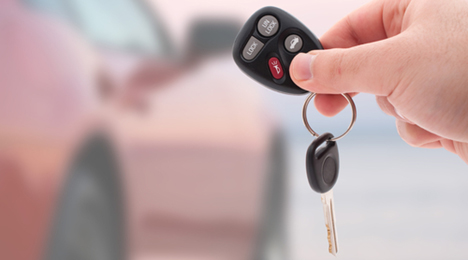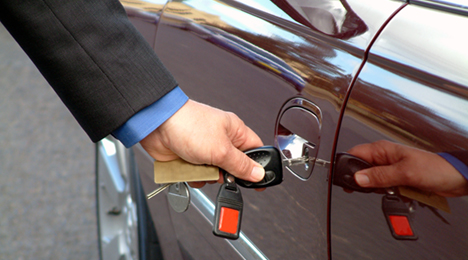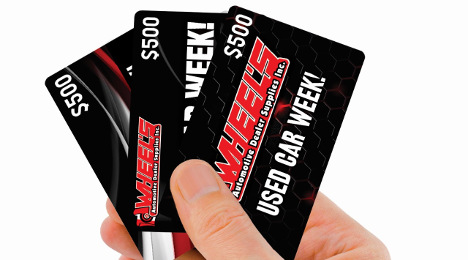Certified pre-owned is taking thicker slices of that franchised dealer used-car sales pie. In fact, CPO share has reached a new landmark.
In the third quarter, 23.2 percent of used-vehicle sales at franchised dealers were certified, according to the latest Used Vehicle Market Report from Edmunds.com.
Certified pre-owned’s Q3 share has never before reached this mark, Edmunds said.
Out of the 2.92 million used vehicles that franchised dealers sold last quarter, 675,551 were CPO, according to the report. Those quarterly certified figures are a 3.4-percent year-over-year hike.
Meanwhile, the record third-quarter share for CPO is up from 21.8 percent a year ago.
“The trend was compounded by a slight decrease in overall franchised used sales, stemming from a decrease in trade-ins on new-car sales,” Edmunds said in the report.
Year-to-date through September, just 45 percent of new-car sales have had a trade-in, the company said. That’s down a couple percentage points from a year ago. There have been 4.71 million trade-ins so far this year; at this time in 2015, it was closer to 5 million.
More ‘near-new’ cars
Another factor perhaps favoring CPO: inventory is getting younger.
Cars ages 3 years or younger accounted for 60 percent of all franchised dealer used-vehicle sales in Q3, Edmunds said. That share has steadily climbed in each of the last four years after coming in at 46 percent in 2012.
That speaks to one of the key takeaways that Edmunds listed in the report: “Changes in new-car buying behavior are beginning to alter the landscape of franchised used vehicles. Continued growth in leasing combined with fewer trade-ins are skewing used vehicle inventories towards near-new vehicles.”
A used car sold at a franchised dealer lot last quarter was, on average, 4.0 years old. A year ago, it was 4.3 years.
Roughly 20 percent of franchised used sales in Q3 were 3-year-old units, up from just over 16 percent a year ago, according to an Edmunds chart.
And lease returns are playing a big part in that and in the overall age decrease on dealer lots. Lease volume was up 25.6 percent year-over-year in 2013, and many of those are now re-entering the market as used.
Put differently, Edmunds said in the report: “From 2012 to 2013, lease volumes increased by 658K units, which has significantly altered today’s franchise used dealer inventories.”
Looking forward
Near-new inventory is grabbing more share on franchised dealer lots — and don’t expect that to stop any time soon.
Lower trade-in figures, a flattening of new-car sales and ever-rising lease rates are swaying the market younger.
Regarding the latter, lease penetration — on a rise the last four years — has reached 31 percent year-to-date, Edmunds said. Similarly, lease volume for the year is now at 3.23 million.
“The growing trend of new-vehicle buyers either not having a trade-in or not willing to part with their vehicle at the dealership is beginning to take effect on the used market,” Edmunds said.
“Plateauing new-car sales combined with a lower share of trade-ins has regressed the overall trade-in volume to 2014 levels,” it continued. “With trade-ins averaging 6 years old and fewer of them on dealer lots, the recent level of lease volumes sets the stage for vast amounts of near-new inventory dominate the used-car market for years to come.”
We all know today’s automotive market is tricky to navigate. As margins compress and sales slow, your job is to make sure that when consumers do decide to purchase a vehicle, they’ll purchase from your dealership. Of course, that’s all great in theory. Making it happen in practice, though, takes a complete understanding of exactly what today’s consumers are looking for.
And these days, consumers are looking for certified pre-owned (CPO) vehicles.
The CPO sector is thriving, with an estimated 3 million consumers currently in the market for CPO. And that number is only getting bigger. Three million more vehicles are expected to come off lease in 2016, which could expand the CPO market to 5.2 million consumers by 2020. That’s 5.2 million reasons to make CPO a cornerstone of your dealership. Because consumer demand for CPO is so high, it creates a major opportunity to increase your profit margin on used vehicles — all while improving consumer satisfaction and loyalty.
But if that’s the case, why do CPO vehicles only make up 21 percent of used vehicle sales at franchise dealerships? In my opinion, the biggest reason is this: Many dealers don’t know how to create a CPO program that meets consumers’ needs. Fortunately, those needs aren’t complicated — in fact, it all comes down to three things.
1) Stocking the Right Vehicles
Consumers don’t go shopping for warranties — they find a car in the make and model they want, and then they consider options like CPO. To build a successful CPO program, focus on stocking the most attractive vehicles possible. Because no matter how good your CPO program is, it can’t make up for a bad car.
What makes a CPO vehicle compelling depends on your market, but most consumers expect the basics: manufacturer or dealership certification, detailed inspection, extended warranty. Still, to really knock it out of the park, you’ll have to think bigger. The best CPO candidates are your most in-demand used vehicles: popular makes and models, in top condition, with the latest technology.
A good warranty won’t make a bad car more attractive, so if you’re stuck with slow-moving inventory, CPO isn’t the solution. But for in-demand inventory, certifications can increase a vehicle’s value, making your best inventory — and your profit margins — even better.
2) Offering the Right Benefits
The importance CPO consumers place on vehicle quality reveals one important trait about their purchase habits: They prioritize value over price. By choosing CPO, consumers prove they’re willing to pay more for a car that goes beyond the basics. So why not build in a benefits package that adds even more value?
The most effective CPO benefits packages address these three areas:
—Maintenance. 57 percent of used car shoppers choose a CPO vehicle because of the safety the warranty provides. Offering free oil changes, one-year cosmetic damage protection or tire damage coverage can enhance that safety benefit, encouraging more consumers to take the plunge into CPO.
—Security. Peace of mind is a deciding factor for 64 percent of CPO consumers. Certifications and warranties provide some security, but your benefits package can take it to the next level. Features like GPS tracking, vehicle alarm notifications or engine failsafe mode can provide the security CPO consumers crave.
—Concierge. Consumers want a safe and secure vehicle, but they also care about their overall ownership experience. Offering services like loaner vehicles, free car washes or vehicle pickup for service appointments can increase consumer satisfaction; it also boosts your retention potential. If your benefits package covers all three segments, the results could be bigger than you think. Great benefits packages have been shown to increase CPO purchase interest by 38 percent!
3) Listing the Right Price
While consumers clearly understand the value of CPO, too many dealers underestimate the profit potential of this key market segment. The average consumer is willing to pay $3,000 more for a CPO vehicle than for the same vehicle without a certification. Dealers, on the other hand, estimate that increase at just $1,260. By recognizing the value consumers place on CPO, most dealers could be earning $1,740 more per vehicle than they currently are!
Because CPO vehicles are so compelling, they can sell with a higher price tag … and they sell faster, too. On average, a frontline-ready CPO vehicle sells in 30 days — five days faster than an ordinary used car. That increase in velocity raises dealers’ number of inventory turns from 10.4 per year to 12. In other words, by certifying your used vehicles, your dealership can earn the equivalent of an extra month and a half of selling time.
True, inspecting and certifying used vehicles requires some initial investment. But with the combined benefit of higher price tags and faster turns, CPO’s small upfront cost is more than worth it.
It’s easy to see why today’s consumers are so interested in CPO. These reliable, safe, high-quality vehicles are a great fit for millions of consumers looking to purchase. And if your dealership delivers the right vehicles and the right benefits for the right price, there’s no end to the value you can earn.
Rob Christman is the fixed operations director of sales at Cox Automotive.
Here’s an opportunity dealers might be missing: consumers are willing to pay more for CPO than you think.
On average, a consumer would shell out $3,000 more on a certified pre-owned car than a non-CPO version of the same car, according to the Cox Automotive 2016 CPO Study.
But here’s the thing.
Dealers think they will only pay $1,260 more.
This underestimate, Cox Automotive says, shows that dealers are perhaps leaving some cash on the table.
Another missed opportunity? CPO sales are still a very small part of franchised dealers’ used-car business.
Citing 2010 through September 2016 rolling year-to-date data from NADA and Autodata/Motor Intelligence, Cox Automotive indicates that certified represents less than a quarter of franchised dealer pre-owned sales.
“CPO vehicles are a smart investment for any dealership,” said Scott Hernalsteen, senior director of research and market intelligence for Cox Automotive Media Group. “That said, CPO only accounts for 21 percent of used-vehicle sales at franchise dealerships.
“This study proves that CPO vehicles are especially valuable for today’s consumers, and should encourage dealers to take advantage of untapped CPO opportunities.”
The CPO market could reach its sixth straight year of record sales. And it might not be done.
Cox Automotive found that there are currently 3 million consumers who are interested in CPO. But that number could grow to 5.2 million.
Citing 2008 through September 2016 rolling year-to-date data from IHS/PolkInsight, Cox Automotive said one driver for this interest is the 4.6 million leases projected to end between now and 2020.
“Dealers who convert lessees into CPO customers — and certify returning vehicles before putting them up for sale — can harness the sales and profit that come with CPO vehicles,” the company said in a news release. “Dealers who also precisely match inventory to their market and deliver exceptional customer experience could see CPO sales grow exponentially.”
More information is available by clicking here.
On Tuesday, Autotrader shared its favorite certified pre-owned November special deals and offers available to shoppers through the end of the month.
"Holiday shopping can put a pinch on budgets, and the potential problems associated with used vehicles can make shoppers wary," said Brian Moody, executive editor at Autotrader. "That's where certified pre-owned cars and trucks come in. Often lightly used and accompanied by a long factory warranty, CPO vehicles offer greater peace of mind than a regular used vehicle — at a more reasonable price point than a new one."
Autotrader editors' top picks for November CPO deals
— Audi's CPO program offers six years or 100,000 miles of bumper-to-bumper coverage. Buyers paying cash get $500 back on the 2014 A4, 2014 A6 and 2015 A3 models. Audi also provides its qualified shoppers 1.9 percent interest for up to 60 months on all 2013 to 2015 models.
— Chevrolet is recognized for its attractive powertrain warranty. Its CPO program covers vehicles for up to five years or 100,000 miles from the original sale date and offers a bumper-to-bumper warranty that includes an extra year or 12,000 miles to the original warranty.
— Hyundai provides its CPO shoppers 10 years or 100,000 miles of powertrain protection, and five years or 60,000 miles of bumper-to-bumper coverage from the vehicle's original sale date. Also, all month long, Hyundai offers qualified CPO Elantra and Sonata shoppers 0.9 percent interest for up to 48 months.
— Attractive to luxury vehicle shoppers is Jaguar's CPO warranty that offers six years or 100,000 miles of bumper-to-bumper coverage that is fully transferrable and has no deductible. Additionally, this month qualified shoppers can get 0.9-percent interest financing for up to 60 months on the midsize XF luxury sedan’s 2013 and 2014 models, and 1.9 percent for up to 60 months on 2015 models.
— Kia's gives qualified CPO buyers a special financing rate of 0.9-percent interest for up to 36 months on all CPO versions of the Optima midsize sedan and Sorento SUV. And all CPO vehicles sold receive powertrain coverage for up to 10 years or 100,000 miles from the original sale date, in addition to bumper-to-bumper protection for a year or 12,000 miles.
— Mazda's CPO program offers a year of extra bumper-to-bumper protection, as well as up to seven years or 100,000 miles of powertrain coverage from the original sale date and 1.49 percent interest for up to 36 months.
— MINI provides buyers up to six years or 100,000 miles of bumper-to-bumper coverage from the original sale date. Qualified CPO shoppers can also look forward to two benefits this month, 0.9-percent financing for up to 36 months on all leased 2013 and 2014 models, and those paying cash get $500 cash back on all 2013 and 2014 CPO purchases.
— At Toyota, shoppers can enjoy both bumper-to-bumper warranty coverage and powertrain coverage protection for up to seven years or 100,000 miles from the original sale date. Additionally, through the end of the month, CPO RAV4 models bring the additional incentive of 1.9-percent financing for up to 60 months to qualified shoppers.

There have been some big changes to the digital marketing landscape — ones that certainly impact dealers, says Kerri Wise, TrueCar's vice president of dealer marketing.
“We're in the era of the empowered consumer,” Wise said in a phone interview with Auto Remarketing. “And I think the consumer is really what's changing.
“They have a lot of information at their fingertips, in terms of pricing information and vehicle information,” she said. “They have technology that's ever-evolving that allows them to have that information wherever they go, in terms of their smartphone.
“And they have high expectations in terms of the experience. So I think with those three elements, in terms of the consumer, it's kind of forcing dealers to also adjust to meet the needs of that consumer.”
In fact, TrueCar recently conducted a study of its dealer partners that closed sales at the highest rates (relative to competitors).
The company found that these dealers were the ones who were strongest at “meeting needs of that empowered consumer and connecting the dots between what happens online and then what happens off-line, in the store — which is a much more difficult thing to do these days,” Wise said.
Wise will discuss this concept of the “evolving consumer” further during her presentation at the CPO Forum, part of the Used Car Week Conferences being held Nov. 14-18 at the Red Rock Casino, Resort & Spa in Las Vegas.
Her session — titled “Key Tactics to Compete and Win in Today's Transparent Marketplace” — will be held at 4 p.m. (PT) on Nov. 15.
“One of the advantages that we have at TrueCar is that we're watching some of the patterns of consumers from shopping all the way through the sale,” she said.
“And so we learn a lot about not only how they shop, but how they're changing. And so I'm going to be using some of that insight from consumers as well as our observations and studying of our top-performing dealers to understand how these top-performing dealers close at a high percent in a transparent way,” Wise said. “It's easier said than done.
“We'll be looking at these consumer insights, combined with these best practices from real dealers that are balancing transparency and balancing their bottom line, and sharing that with the audience in terms of what makes them successful,” she said.
UPDATED to correct October monthly industry/domestic/Asian/European sales figures
Certified pre-owned vehicle sales fell on a year-over-year basis for the second straight month, but are still up 3 percent year-to-date, according to Autodata Corp.
With 2.21 million CPO vehicles sold through 10 months of 2016, full-year sales can still beat last year’s 2.55 million sales and mark the sixth straight year of record results. At this point last year, there had been 2.14 million certified sales.
There were 206,846 certified sales in October, down 3.2 percent from the same month a year ago, according to Autodata.
The daily selling rate was somewhat of a Catch-22, with an average of 7,956 certified cars sold per day. This was 4.3 percent stronger than the DSR from October 2015, but the lowest rate of 2016, Autodata said.
Domestic automakers sold 65,804 certified vehicles in October, down 14.1 percent year-over-year. Through 10 months, they have sold 759,660 CPO units for a 2.9-percent decrease.
The Asian brands moved 105,148 CPO vehicles in October (up 3.3 percent) and have sold 1.08 million this year, which beats year-ago figures by 9.4 percent.
European automakers increased their CPO sales 2 percent in October, moving 35,894 units. Through October, they have sold 364,549 certified vehicles (down 1.6 percent).
Asbury Automotive Group is generating some strong certified pre-owned sales results, but the retailer isn’t satisfied quite yet.
No, the dealership group believes it still has growth potential in CPO and its overall used-car operations.
The topic of certified pre-owned came up several times during Asbury’s quarterly conference call earlier this week, and for good reason — its CPO sales were up 7 percent from a year ago on a same-store basis. This despite overall same-store used sales falling 3 percent.
“We believe there is additional opportunity to grow our used-vehicle unit sales, specifically our CPO sales as additional off-lease inventory comes to market,” chief operating officer David Hult said.
Later in the call, Hult mentioned that some of Asbury’s stronger stores have posted used-to-new ratios slightly higher than 1:1, which beats the industry average. And used volume may help, given some of the margin pressure.
“We’re trying to look at used vehicles in a holistic approach, and understanding what it generates for parts and service and that internal gross, and how we benefit from that,” he said. “As far as margin pressure going forward, I think it will look similar to what it looks like right now. But our opportunity is within the volume aspect … we’re very happy with that CPO increase. We think there’s more opportunity there.
“And we think some things that we’ve been working on within this past quarter will tend to come to fruition, plus the benefit of these stop-sale vehicles actually freeing up,” he said.
Hult also noted that CPO tends to command 35 percent to 40 percent of total used-car sales for Asbury.
“We see that there’s opportunity there to grow that number further,” Hult said.
Asked by call participant whether he sees overall industry CPO sales softening, Hult said that doesn’t appear to the case, based on what they have heard from peers and the industry.
Experian’s latest State of Auto Finance Market Report made headlines, painting a rosy picture for the used-vehicle market. Overall, pre-owned vehicles accounted for 55.61 percent of all financing in the second quarter of 2016.
Consumers across all credit tiers are flocking to pre-owned vehicles, with super-prime and prime consumers accounting for 44.95 percent of all pre-owned loans — a 2.6 percent year-over-year increase.
Dealers have ample opportunity to capitalize on this market dynamic with certified pre-owned programs and F&I products tailored to the pre-owned market.
Remember, the one hurdle pre-owned vehicles have always had to overcome is vehicle reliability. Even in this current market, you can bet vehicle reliability is still a hot button.
In addition, those prime and super-prime consumers are used to another level of sophistication when it comes to customer service and they will expect no less when shopping for pre-owned vehicles. This combination makes strong CPO programs market differentiators.
According to research from EFG Companies, 71 percent of consumers expect a CPO program to consist of:
— Thoroughly checked vehicles that are in working order
— Additional coverage
— Roadside assistance
Evaluate your CPO program based on this criteria. To be certified, your pre-owned vehicles need to pass a stringent inspection and repair process. Some dealers may be tempted to consider the inspection enough for a CPO sticker. However, by doing so they are leaving significant money on the table. Now, I know what you’re thinking: “providing complimentary coverage is an extra cost to me, what benefit do I get by giving away coverage and roadside assistance?”
To answer this question I ask that you go to your top-producing F&I manager and ask, “Which is easier to sell F&I products on: a car that comes with a warranty or coverage of some sort, or a car with no coverage whatsoever?”
I’m willing to bet your F&I manager will say they get the best penetration rates and the highest margins on vehicles that have a warranty or coverage built in.
Why, you ask? Because with those “built-in” products, your F&I manager has the opportunity to create a need by specifying where and how the coverage ends. Once they create the need, they then discuss the benefits of purchasing additional coverage to fill that need.
When a vehicle doesn’t come with a warranty or any type of complimentary coverage, F&I managers are often left floundering, trying to discover where to start the product presentation. This makes their jobs that much harder.
So yes, providing complimentary coverage is an added cost, but when weighed against the benefits of increased F&I product penetration and back-end margin, that cost turns into another area to generate revenue.
Of course, the complimentary coverage can’t be just any F&I product. Good CPO programs come with some form of limited powertrain coverage with roadside assistance, and possibly a short-term maintenance plan. With limited powertrain coverage, F&I managers have the potential to upgrade customers to a full vehicle service contract with nationwide roadside assistance.
With a short-term maintenance plan, your managers in finance and in the service drive will have ample opportunity to upgrade customers to longer-term and/or more comprehensive maintenance plans. In addition, these products offer good spring-boards into discussions around interior and exterior protection products.
John Stephens is executive vice president at EFG Companies. Other commentaries from EFG can be found at efgintelligence.com/dealershipcorridor.
Building a successful certified pre-owned program takes work — and an in-depth understanding of your customer base. If you have a good grasp of your customers’ needs, you can easily identify which ones will be a good fit for a CPO vehicle.
And by targeting those customers effectively, you can tap into today’s profitable CPO market, earning more sales and more satisfied customers.
But if you get your targeting wrong and advertise CPO to customers who aren’t interested, you’ll waste your ad dollars, as well as your CPO opportunity.
Fortunately, finding the perfect matches for your CPO program is simple. That information is already logged in your CRM. You just have to know what you’re looking for. By prospecting your CRM for these four major opportunities, you’ll be able to match the right CPO offer to the right customer, keeping them satisfied and your CPO sales numbers high.
CPO opportunity 1: Credit-challenged buyers
Many customers would love to purchase a new car, but can’t get approved for a loan to finance one. These buyers are a prime target for CPO vehicles, which provide the peace-of-mind of a new vehicle, but at lower price points. If you have customers in your CRM who were recently denied a new car loan, now’s the time to reach out and share the benefits of CPO.
Educating these buyers is critical — because a third of new-vehicle shoppers still don’t know much about CPO programs. And even if customers are relatively CPO-savvy, they might not know that your dealership has CPO options. Promoting CPO in your messaging and on your website is a great way to raise market awareness about your offerings.
And by targeting credit-challenged customers with these messages, you can get them the car they want while boosting your CPO sales.
CPO opportunity 2: Expiring leases
New-car lessees are excellent targets for CPO programs. You know they’re committed to driving high-quality, proven-safe vehicles.
You also know they aren’t interested in paying the full price of owning a new vehicle. CPO vehicles offer the same high quality and financial benefits of a new-car lease, along with the added perk of owning the vehicle long-term.
Scan your CRM for customers with fast-approaching end-of-lease terms. These customers are a great target for CPO, since you know exactly when they’ll be coming back to your dealership. They might be thinking about purchasing their next vehicle instead of leasing — and you should make CPO top-of-mind when they’re making that decision. On the other hand, if they’d rather sign another lease, CPO can still be in the picture.
CPO leases are highly attractive for many customers, and are generally more cost-effective than new-vehicle leases.
CPO opportunity 3: Frequent service visits
A great way to tell whether a customer will be a good fit for CPO is by looking at their service history. Since 10 percent of Americans will drive with their “check engine” light on for three months or more, a customer who regularly visits your dealership for service is probably more safety-conscious than the rest. And safety and security are among CPO’s biggest draws.
When asked why they chose a CPO vehicle, the most common answers customers gave were “the warranty” and “peace-of-mind.” In fact, 57 percent of vehicle shoppers purchased a CPO vehicle because of the warranty’s safety benefits.
If you’ve tied your service data to your CRM, you can easily search for active service customers. Then, target those customers with messaging that emphasizes CPO’s safety benefits. They’ll appreciate the extra peace of mind you’re offering — and you’ll appreciate the extra CPO sales.
CPO opportunity 4: Recent CPO purchases
To make your CPO program thrive in the long term, it’s important to keep working to understand your customers after they purchase. But just how important is it? Well, let me tell you a story.
Back in the 1960s, an Italian businessman wanted to treat himself to the finest sports car in the world: a Ferrari. But when he took his new vehicle on the road, he encountered one mechanical issue after another.
Even worse, the more often he brought his vehicle back for service, the more the dealership started to suspect he was the problem, not the car. Fed up, the businessman — named Ferruccio Lamborghini — decided to start manufacturing his own automobiles. And the rest is history.
Obviously, you aren’t selling CPO Lamborghinis, but the lesson remains the same: Interactions after the sale are just as important as what happens before.
Even if a customer has already bought a CPO vehicle, you should make sure you’re meeting their needs after the purchase.
For example, if a customer has purchased a CPO vehicle but didn’t opt for a vehicle service contract, that’s a prime opportunity to provide post-sale value. Inform existing CPO customers of the additional safety benefits and features a VSC can provide.
By looking out for your customers’ needs both now and in the future, you’ll nurture long-term relationships that increase your odds of additional revenue, referrals and retention.
Your dealership’s CRM is your key to matching the right CPO offers to the right customers. By making the effort to understand your customers’ needs and nurture personalized relationships through the CRM, you can tap into a source of sales and referrals that can keep your CPO program successful — instead of losing customers to the competition.
Rob Christman is the fixed operations director of sales at Cox Automotive.
Wheel’s Automotive Dealer Supplies will award $500 gift cards to three lucky dealers during Used Car Week next month.
The gift cards are redeemable toward Wheel’s extensive line of custom, print-on-demand signs, banners, window stickers, hang tags, flags, and multi-dimensional merchandising solutions.
Visitors may enter the drawing by visiting booth No. 210 at Used Car Week, set for Nov. 14-18 at Red Rock Casino Resort & Spa in Las Vegas. All entrants will be registered to win an iPad AIR tablet computer. Entrants need not be present at drawings; winners will be notified by certified mail.
Wheel’s is a merchandising expert in certified pre-owned, and is partnered with 17 OEMs’ CPO programs.
“Dealers often fall back on familiar lot merchandising elements because it’s easy to redo what you already know, but stale merchandising may not pull in buyer interest that new ideas are more likely to do,” said Richard Ashworth, president, Wheel’s Automotive Dealer Supplies.
“Dealers who visit us at Used Car Week will clearly see how we partner to create the freshest, most innovative ideas in used-car merchandising signage — and three lucky dealers will enjoy these products drawing consumer eyes to their inventory at their dealership.”
The following tips can help dealers manage the cost of their merchandising investment while achieving the goal of getting shoppers’ attention:
-
Think it The wrong or wrong number of signs, balloons, and pennants may be perceived as clutter or the wrong message.
-
Be consistent. Mismatched merchandising creates an impression of imbalance, which can create an uncomfortable environment — not a prudent way to start a sale.
-
Be legal. Check local signage laws before you order.
-
Save: Coordinate purchases and consolidate shipping by using a single vendor where possible to save time and money.
-
Get innovative. The same merchandising ideas you’ve used before may not delivery as well in today’s market, especially when marketing certified preowned vehicles. Source a creative supplier willing to work with you to create your ideas and make them reality.
For more information, contact Renee Perri, vice president of corporate division, at (800) 465-8831, ext. 105, or visit www.wheelsauto.com.












